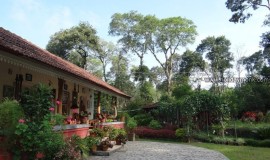
General Information About Coorg
The misty hills, lush teakwood and sandalwood forests, and acres of tea and coffee plantations of Kodagu are, in a word, stunning. Also known as Coorg and dubbed "The Scotland of India," Kodagu is a postcard-perfect region of scattered villages and hamlets, which are the epitome of old-world charm. Kodagu is ideal for outdoor activities such as trekking, angling and white-water rafting, and major festivals like Keil Poldu (worship of weapons), Cauvery Shankaramana (return of the river goddess) and the Huttari (harvest) festival are a huge draw. Popular places in Coorg include Kakkabe, which is also the largest producer of honey in south Asia. One of the main religious sites here is the ancient Omkareshwara Temple. Nagarhole National Park is another popular tourist attraction that is home to a variety of wildlife such as elephants and panthers. With its economy dependent on agriculture, plantations and forestry, Coorg is considered to be one of the most prosperous districts in Karnataka. Known as the ‘Coffee Bowl of India’, Coorg contributes 30% to the total coffee production in India. Besides coffee and pepper, cardamom and oranges are the other mainstays of Coorg’s economy. Set amidst verdant valleys, misty hills and acres of coffee plantations, Coorg is a perfect getaway for travelers. Coorg is also a paradise for adventure junkies. Its hills are a perfect for adventure activities like trekking, rock climbing, biking and white water rafting. December to May is the best time to trek in Coorg. Tourists can contact local organizations like the Coorg Adventure Club, which organises regular trekking expeditions for interested travellers to prominent peaks like Brahmagiri, Pushpagiri, Mandalpatti and Tadiandamol. For white water rafting, holidaymakers can visit Barapole in Coorg.
Sports Played in Coorg
Play different types of sports other than you normally play in ground.Coorg Tourism
Located amidst imposing mountains, dense forests, mist kissed coffee plantations, verdant valleys and challenging treks, Coorg (Kodagu) is the place to be for nature lovers and adventure enthusiasts alike. And yes, this place is true to all those Coorg (Kodagu) tourism postcards. Also known as Kodagu and nicknamed as the "Kashmir of South", Coorg (Kodagu) is one of the precious gems in Karnataka's crown. Located in the Western Ghats of south-western Karnataka, it can be pictured thus: miles of undulating topography carpeted in green covered with a misty veil, thickets of bamboo, sandalwood and rosewood forests. You will also see many stunning waterfalls and ravines, numerous streams and rivulets winding their way through the landscape, sectors of paddy fields and coffee bushes interspersed with grassy downs and intriguing spice farms full of pepper, cardamom, oranges, nutmeg, turmeric, lemon grass, etc. Coorg (Kodagu) a dreamland beyond belief. Coorg offers a unique blend of adventure and tranquillity. The hill station has some interesting treks such as Pushpagiri, Tadiandamol and Brahmagiri Peaks which are quite challenging and blessed with oodles of natural beauty. However, outdoor activities go beyond trekking here. You can try angling in Kaveri River and golfing at Coorg Golf Links (Bittangala), Golf Course (Pollibetta) and Mercara Downs (Mercara). An ideal summer retreat, Coorg (Kodagu) tourism offers some wonderful moments of relaxation and rejuvenation. You could plan your trip in monsoon as the place looks its best during rains.
Coorg Culture and History
History
The northern part of Coorg district was under the reign of Kadambas between the 2nd and 6th century. However, after a war between the Kadambas and the Gangas in the 11th century, the Cholas were the sole rulers of this province. After the 12th century, the Hoysalas, who were ruling Hassan district, defeated the Cholas and in the 14th century, the Vijayanagara kings took over and ruled the province. After their downfall, the local Nayaks took over different parts of Coorg. The war between different rulers of the province and the Haleri kings made the latter the new rulers of Coorg from the year 1600 to 1834, and after their reign ended, the region of Coorg was under colonial rule. Coorg was declared as an independent state in the year 1950 by the Indian Constitution and when many Indian states were reorganised in the year 1956, Coorg was merged with the state of Karnataka and declared a district. Coorg has three taluks which include Madikeri, Somavarapete and Veerajapete.Landscape
It might seem surprising that while the landscape of Coorg is contrasting, its people are fused in their love of farming. Whilst the taller ranges are at the 4000 feet level, the lower ranges are at mid-2000 feet levels. While higher elevations are suitable for the Arabica variety of coffee, the lower regions are right for the selection termed Robusta. The hills are a melange of native indigenous trees, shrubs, and natural undergrowth. Planting of coffee in the hills involves clearing a certain amount of the undergrowth, whilst maintaining most of the upper shade cover, which comprises mostly native forest trees. The list of native trees growing and thriving in the landscape is large, diverse and eye-catching.
SELECT
The Tamara Coorg
The Tamara Coorg Coorg India

SELECT
The Serai Kabini
The Serai Kabini Coorg India

SELECT
Highland Coorg Resort
Highland Coorg Resort Coorg India

SELECT
Exotic Madikeri Resort
Exotic Madikeri Resort Coorg India

SELECT
Country Holiday Resort
Country Holiday Resort Coorg India

SELECT
Coorg Bliss Resort
Coorg Bliss Resort Coorg India

SELECT
Madikeri Plantation Retreat
Madikeri Plantation Retreat Coorg India

SELECT
Heritage Cottage in Coorg
Heritage Cottage in Coorg Coorg India

SELECT
Estate Heritage House Madikeri
Estate Heritage House Madikeri Madikeri India

SELECT
Dormitory Homestay in Somwarpet
Dormitory Homestay in Somwarpet Coorg India

SELECT
Biddanta Estate Homestay
Biddanta Estate Homestay Coorg India

SELECT
Red Brick House Homestay near Srimangala










